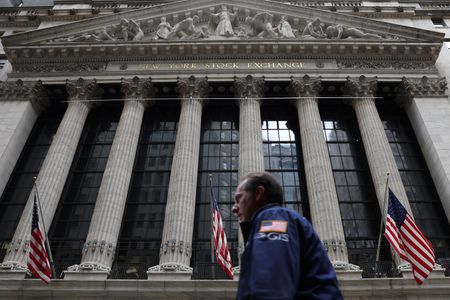By Lewis Krauskopf
NEW YORK (Reuters) – U.S. stocks are starting 2023 at much cheaper levels after Wall Street’s biggest swoon in 14 years but the potential for a recession combined with higher interest rates means equities may not be priced low enough to lure investors.
Since the S&P 500 reached an all-time high a year ago, the index’s price-to-earnings ratio has fallen over 20% from its peaks to levels closer to historic averages.
Some investors remain skeptical. Stocks may be more expensive than they appear if current earnings estimates do not fully account for any economic slowdown, while any downturn could further dampen what investors are willing to pay for equities.
Even so, a surprise drop in the U.S. jobless rate reported on Friday seems to have raised optimism about a soft economic landing.
“Valuations have corrected, but they are still not compelling relative to the macro challenges that exist,” said Keith Lerner, co-chief investment officer at Truist Advisory Services, which rates fixed income as more attractive than equities.
“At best, you can say that valuations are average,” Lerner said, “but the question I think you have to ask yourself is average enough given elevated recession risk?”
The S&P 500 tumbled 19.4% in 2022, as the Federal Reserve’s aggressive rate hikes designed to tamp down 40-year high inflation punished asset prices. As of midday Friday, the benchmark stock index was 0.8% firmer in the first week of 2023.
The market’s 2022 slide cut the ratio of price to forward earnings estimates to around 17 from about 21.7 a year ago, according to Refinitiv Datastream. The current level of 16.3 remains slightly above the index’s 15.8 average of the past 20
years.
Valuations may still be too high if a recession comes to pass, as many on Wall Street expect. Fund managers in last month’s BofA Global Research survey cited a deep global recession and persistently high inflation as the market’s biggest risks, with a net 68% forecasting a likely downturn in the next year.
UBS economists forecast a recession from the second through fourth quarters of this year, “as rate hikes push a vulnerable economy into contraction.”
“As growth deteriorates considerably into Q2/Q3, we assume the multiple falls toward 14.5 (times),” UBS equity strategists said in a note. Combined with an expectation of weakening earnings estimates, that would lower the S&P 500 to 3,200, UBS said, roughly 16% below current levels.
Any recession could pressure corporate profits more than is factored into projections. Consensus analyst estimates call for a 4.4% increase in earnings this year, according to Refinitiv IBES.
Yet during recessions, earnings fall at an average annual rate of 24%, according to Ned Davis Research. If estimates are overly rosy, that means the P/E ratio is higher than it appears, making stocks seem less attractive.
The profit picture will start to become clearer as fourth-quarter earnings season kicks off next week. Reports are due from banks Wells Fargo and Citigroup, healthcare titan UnitedHealth Group, asset manager BlackRock and Delta Air Lines.
The 2022 surge in interest rates also could undermine stock valuations by making relatively safe assets like U.S. Treasuries more attractive alternatives. Yields on benchmark Treasuries jumped to 15-year highs last year after a long period when relatively safe assets yielded little.
“The problem with the valuation analysis right now is the old saying was there is no alternative to stocks because interest rates were so low,” said Matthew Miskin, co-chief investment strategist at John Hancock Investment Management.
With interest rates “significantly higher than they were the last decade … that higher multiple you used to pay for stocks may not be as justified,” he added.
The equity risk premium, or extra return investors expect to receive for holding stocks over risk-free government bonds, has become less favorable over the past year, according to Truist’s Lerner.
The current premium coincides with a 12-month excess return of 3.5% for the S&P 500 over the 10-year Treasury note, but “downgrades to the economy and earnings remain risks,” Lerner said in a note.
The S&P 500 rose 1.7% on Friday after the Labor Department said that the unemployment rate last month was a lower-than-expected 3.5%, and November’s was a downwardly revised 3.6%. Nonfarm payrolls rose 223,000, beating estimates and still showing a strong labor market, but less than November’s 256,000 jobs added.
A cooling of wage increases raised hopes that the Fed will continute to temper the aggressive rate hikes it delivered last year. The market now shifts attention toward Thursday’s December consumer price index report, which could also influence the Fed’s tightening path this year.
Investors are searching for bargains. State Street Global Advisors prefers mid-cap and small-cap stocks to their large-cap counterparts, said State Street’s chief investment strategist Michael Arone.
The S&P 400 midcap index and the S&P 600 small-cap index are both trading at around 13 times forward earnings estimates, well below their respective long-term averages, according to Refinitiv Datastream.
“As you move down in market capitalization, the valuations become more attractive,” Arone said.
(Reporting by Lewis Krauskopf and Alden Bentley; Editing by Richard Chang and David Gregorio)

